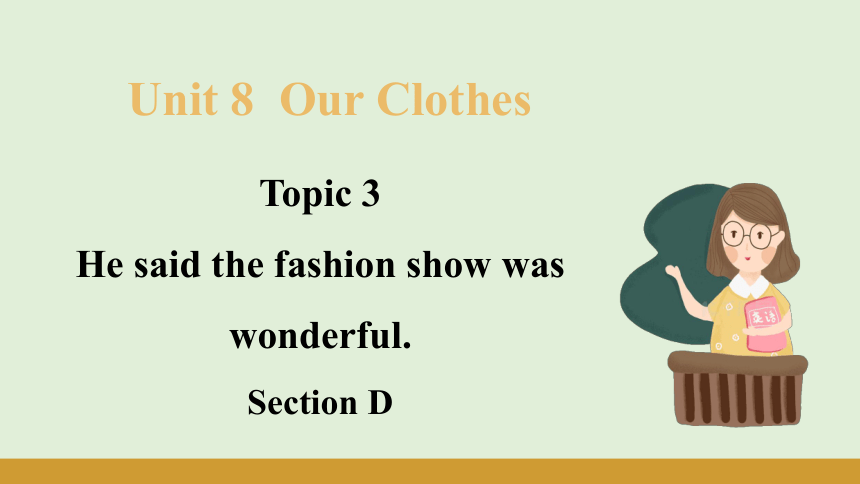(
课件网) Unit 8 Our Clothes Topic 3 He said the fashion show was wonderful. Section D 正确运用本话题所学语言知识完成练习,夯实语言知识; 能够读懂语篇内容,在练习中把握语篇大意和细节,了解美国和日本的服装特点、材质、发展变化; 了解旗袍的信息,讨论并写一篇文章介绍旗袍,提高“写”的语言能力; 设计时装秀,并写短文汇报时装秀情况,培养用英语做事情的意识和逻辑思维能力。 What do you know about the Tang costume and qipao Example: —The Tang costume stands for Chinese history and fashion culture. —People designed the qipao in the Qing dynasty. Look and talk. adj. 众所周知的,著名的 n. 一件商品(物品);项目 n. 选择;挑选 n. 结婚,婚姻 n. 庆祝;庆祝会 well-known item choice marriage celebration Object clauses (IV) Kangkang said he _____ (watch) it. And he said the fashion show _____ (is) wonderful. She asked Kangkang what he _____ (be) doing. She said she _____ (wear) a Yao minority costume. Read through Sections A-C carefully and fill in the blanks with the correct words. watched was was wore People _____ it qipao. _____ come three other models, and they are also in minority costumes. That’s really _____! Today people can design the Tang costume as _____ formal _____ casual clothes. Read through Sections A-C carefully and fill in the blanks with the correct words. call Here cool either or America ● The well-known item of American clothing is blue jeans. ● In the past, many workers wore heavy cotton jeans. ● Today, clothing factories make many different styles and colors of jeans. ● They are the most popular choice of clothing for young people around the world. Read the following information and complete the table on Page 104. 1 Japan ● The kimono is the Japanese traditional clothing. ● The traditional kimono was made of silk. ● At one time, Japanese people wore kimonos for casual and formal occasions. ● Today, few people wear kimonos except on special occasions like marriages and national celebrations. Read the following information and complete the table on Page 104. 1 Country Traditional clothing Material Occasion to wear In the past Today working kimono America Japan blue jeans cotton silk casual and working casual and formal formal Read the following information and complete the table on Page 104. 1 1. In the past, many workers wore heavy cotton jeans. 过去,许多工人穿着厚厚的棉制牛仔裤。 heavy除了有“重的,沉的”意思之外,根据所修饰的名词,还有不同的汉语意思。 e.g. a heavy crop 大丰收 a heavy rain (snow, fog ...) 大雨(雪,雾……) a heavy heart 沉重的心情 with a heavy hand 严厉的手段 2. They are the most popular choice of clothing for young people around the world. 对世界各地的年轻人来说,它们是最受青睐的。 (1) choice n. 选择,挑选。 (2) choose v. 选择,挑选。过去分词为 chosen。 e.g. Jane chose a red shirt. 简选了一件红色连衣裙。 e.g. Nancy bad no choice but to leave. 除了离开,南希别无选择。 3. At one time, Japanese people wore kimonos for casual and formal occasions. 有一个时期,日本 ... ...

